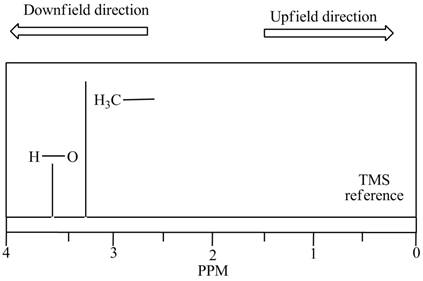
Concept explainers
The
two signals, one due to the
absorption. (b) Do the
(a)
Interpretation: The chemical shifts of the given absorptions are to be calculated.
Concept introduction: In NMR spectrum, peaks are known as resonances, lines or absorptions. On the horizontal axis, the position of absorption is generally referred to as chemical shift. The chemical shift of any absorption is calculated by the formula,
Answer to Problem 14.1P
The chemical shifts of the given absorptions are
Explanation of Solution
The observed chemical shift due to the
The observed chemical shift due to the
The operating frequency is
The conversion of
Therefore, the conversion of
Chemical shift
Chemical shift due to
The chemical shift of absorption is calculated by the formula,
Where,
Substitute the values of observed chemical shift and operating frequency in the above formula to calculate the chemical shift due to
Therefore, the chemical shift is
The conversion of
Therefore, the conversion of
Hence, the chemical shift is
Chemical shift due to
Substitute the values of observed chemical shift and operating frequency in the above formula to calculate the chemical shift due to
Therefore, the chemical shift is
The conversion of
Therefore, the conversion of
Hence, the chemical shift is
The chemical shifts of the given absorptions are
(b)
Interpretation: Whether the
Concept introduction: In NMR spectrum, peaks are known as resonances, lines or absorptions. On the horizontal axis, the position of absorption is generally referred to as chemical shift. The increasing order of chemical shift is plotted from right to left in NMR spectrum.
Answer to Problem 14.1P
The peak of
Explanation of Solution
The terms, upfield and downfield expresses the relative location of signals. The meaning of upfield is to the right and of downfield is to the left. The

Figure 1
Hence, the peak of
The peak of
Want to see more full solutions like this?
Chapter 14 Solutions
ORGANIC CHEM.(LL)W/STD GDE.+CONNECT PKG
Additional Science Textbook Solutions
Organic Chemistry
Principles of Chemistry: A Molecular Approach (3rd Edition)
Introductory Chemistry (5th Edition) (Standalone Book)
Organic Chemistry (8th Edition)
Chemistry: The Central Science (13th Edition)
- Assign as many resonances as you can to specific carbon atoms in the 13C NMR spectrum of ethyl benzoate.arrow_forwardThe following 1H NMR peaks were recorded on a spectrometer operating at 200 MHz. Convert each into δ units. (a) CHCl3; 1454 Hz (b) CH3Cl; 610 Hz (c) CH3OH; 693 Hz (d) CH2Cl2; 1060 Hzarrow_forwardWhen the 1HNMR spectrum of an alcohol is run in dimethylsulfoxide (DMSO) solvent rather than in chloroform, exchange of the Ο-H proton is slow and spin-spin splitting is seen between the Ο-H proton and C-H protons on the adjacent carbon. What spin multiplicities would you expect for the hydroxyl protons in the following alcohols? (a) 2-Methyl-2-propanol (b) Cyclohexanol (c) Ethanol (d) 2-Propanol (e) Cholesterol (f) 1-Methylcyclohexanolarrow_forward
- Explain the chemical shift of each unique proton in 1H NMR spectrum and each unique carbon in 13C NMR spectrum of methyl salicylate.arrow_forwardThe 1H NMR spectrum of chloromethane recorded on a 300 Hz NMR spectrometer consists of signals at 444 Hz and 1071 Hz downfield from TMS. Calculate the chemical shift of each absorption. Give answer in parts per million.arrow_forwardHow many signals will be found in the 13c NMR of 2 propanol at room temperaturearrow_forward
- These are four alcohols with the formula C4H10O. One of them produced this C-NMR spectrum, which alcohol did that and what carbons correspond with what peaks?arrow_forwardWhen the 1î-NMR spectrum of acetone, CH3COCH3, is recorded on an instrument operating at 200 MHz, a single sharp resonance at 2.1î is seen. (a) How many hertz downfield from TMS does the acetone resonance correspond to? (b) If the 1î-NMR spectrum of acetone were recorded at 500 MHz, what would the position of the absorption be in î units? (c) How many hertz downfield from TMS does this 500 MHz resonance correspond to?arrow_forwardDescribe the 1H NMR spectrum of each compound. State how many NMR signals are present, the splitting pattern for each signal, and the approximate chemical shiftarrow_forward
- In a 300-MHz spectrometer, the protons in iodomethane absorb at a position 650 Hz downfield from TMS. How many hertz downfield from TMS would they absorb at 60 MHz?arrow_forwardWhich of these two compounds will give a 1H NMR spectrum with two signals in a ratio of 2:3? Write down the number of different types of H's and the ratio of the different types of H's .arrow_forwardHow could 1H NMR spectroscopy be used to distinguish betweencompounds X and Y?arrow_forward

 Principles of Instrumental AnalysisChemistryISBN:9781305577213Author:Douglas A. Skoog, F. James Holler, Stanley R. CrouchPublisher:Cengage Learning
Principles of Instrumental AnalysisChemistryISBN:9781305577213Author:Douglas A. Skoog, F. James Holler, Stanley R. CrouchPublisher:Cengage Learning

